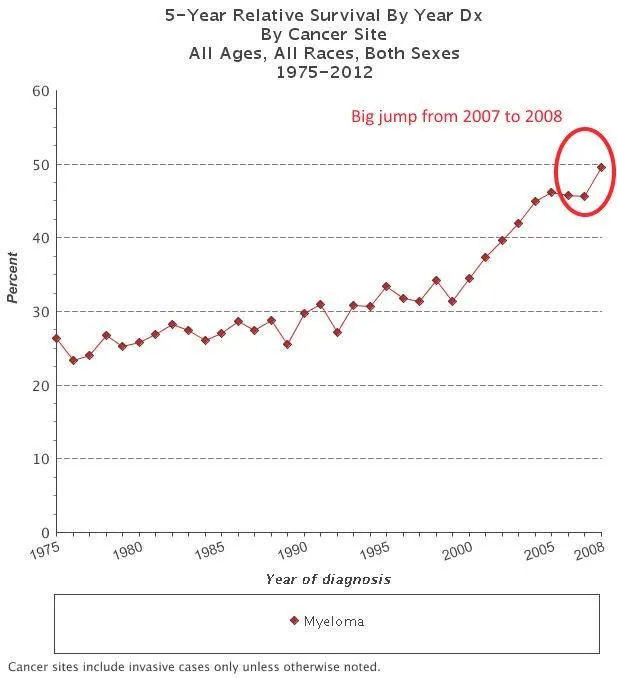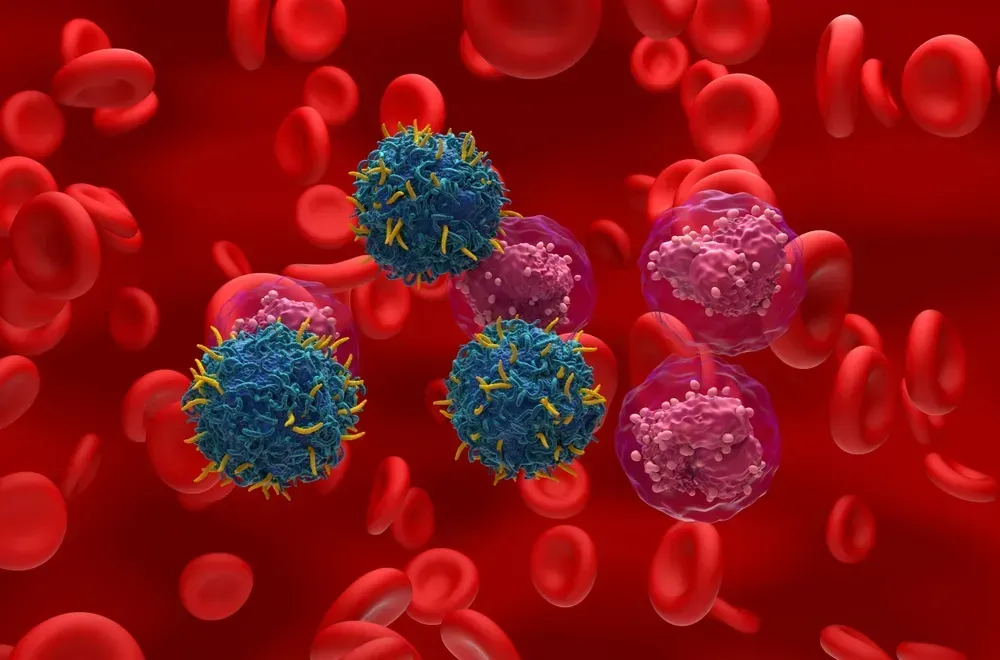Multiple Myeloma Survival Improved To 5 Years! Yeah!!! And My Future Survival Prediction For the Next Two Years.

If you are a myeloma patient, you have to love this news. When I was diagnosed there was little data available, but I do remember a Mayo publication which said the average life expectancy was 33 months and had not changed in a decade. The new patients can now look at the new data represented in the graph below, and it looks as though the sky is the limit for survival. And if you are lucky enough to make it through the first 2 years after diagnosis, the sky IS the limit. We unfortunately still lose 30% of patients in the first 2 years, and this has not changed much in the last 10 years. This has everything to do with late diagnosis, inadequate treatment for the newly diagnosed patients. I will leave further discussion on this subject to another post. But now let us celebrate some outstanding news. For the new SEER data published on 4/15/16 CLICK HERE.
On a blog post last year I predicted this would be the year life expectancy reached 5 years, and you can view my prior prediction if you CLICK HERE. My new prediction is that in two more years life expectancy will increase by another year to 6 years.
Below is a look at the history of the survival for myeloma in the USA and my prediction.
| Year | Survival Milestones | Years Between Milestones |
| 1975 | 2 Years | - |
| 1998 | 3 Years | 23 |
| 2004 | 4 Years | 6 |
| 2008 | 5 Years | 4 |
| 2010 (Prediction) | 6 Years | 2 |
As you can note in the graph and list above, the pace of change has increased significantly to where we are improving life expectancy by one year, in just two years. Whereas, it took 23 years to improve survival by just one year in 1975. And if you have not noticed, the drastic increase in the rate of improvement started in the early 2000's which coincides with the development of IMIDs (Thalomid, Revlimid) and the proteasome inhibitor (Velcade).
With 4 new drugs approved for myeloma in 2015, and two of them representing a new class of drugs (checkpoint inhibitor and monoclonal antibody), we can expect continued improvement for the patients who are fortunate enough to be diagnosed in a timely fashion. The 30% who do not make it 2 years will not share in this because of late diagnosis, wrong diagnosis, and poor first line treatment. More on this subject later.
Good luck and may God Bless your Cancer Journey. For more information on multiple myeloma survival rates and treatments CLICK HERE and you can follow me on twitter at: https://twitter.com/grpetersen1
If you are a myeloma patient, you have to love this news. When I was diagnosed there was little data available, but I do remember a Mayo publication which said the average life expectancy was 33 months and had not changed in a decade. The new patients can now look at the new data represented in the graph below, and it looks as though the sky is the limit for survival. And if you are lucky enough to make it through the first 2 years after diagnosis, the sky IS the limit. We unfortunately still lose 30% of patients in the first 2 years, and this has not changed much in the last 10 years. This has everything to do with late diagnosis, inadequate treatment for the newly diagnosed patients. I will leave further discussion on this subject to another post. But now let us celebrate some outstanding news. For the new SEER data published on 4/15/16 CLICK HERE.
On a blog post last year I predicted this would be the year life expectancy reached 5 years, and you can view my prior prediction if you CLICK HERE. My new prediction is that in two more years life expectancy will increase by another year to 6 years.
Below is a look at the history of the survival for myeloma in the USA and my prediction.
| Year | Survival Milestones | Years Between Milestones |
| 1975 | 2 Years | - |
| 1998 | 3 Years | 23 |
| 2004 | 4 Years | 6 |
| 2008 | 5 Years | 4 |
| 2010 (Prediction) | 6 Years | 2 |
As you can note in the graph and list above, the pace of change has increased significantly to where we are improving life expectancy by one year, in just two years. Whereas, it took 23 years to improve survival by just one year in 1975. And if you have not noticed, the drastic increase in the rate of improvement started in the early 2000's which coincides with the development of IMIDs (Thalomid, Revlimid) and the proteasome inhibitor (Velcade).
With 4 new drugs approved for myeloma in 2015, and two of them representing a new class of drugs (checkpoint inhibitor and monoclonal antibody), we can expect continued improvement for the patients who are fortunate enough to be diagnosed in a timely fashion. The 30% who do not make it 2 years will not share in this because of late diagnosis, wrong diagnosis, and poor first line treatment. More on this subject later.
Good luck and may God Bless your Cancer Journey. For more information on multiple myeloma survival rates and treatments CLICK HERE and you can follow me on twitter at: https://twitter.com/grpetersen1

about the author
Gary Petersen
Gary is a myeloma survivor and patient advocate. His work centers around helping patients live longer by helping them to find facilities who are beating the average survival statistics. You can find Gary's site at www.myelomasurvival.com and follow him on Twitter at @grpetersen1
More on Treatment Advances
Trending Articles
Upcoming Events




Get the Latest Multiple Myeloma Updates, Delivered to You.
By subscribing to the HealthTree newsletter, you'll receive the latest research, treatment updates, and expert insights to help you navigate your health.
Together we care.
Together we cure.
3x Faster.











